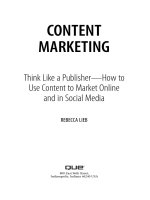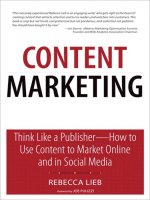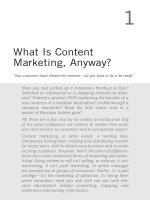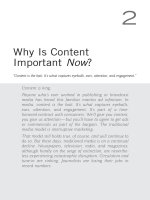Content marketing think like a publisher chapter 2 why is content important now
Bạn đang xem bản rút gọn của tài liệu. Xem và tải ngay bản đầy đủ của tài liệu tại đây (464.63 KB, 6 trang )
2
Why Is Content
Important Now?
“Content is the bait. It’s what captures eyeballs, ears, attention, and engagement.”
Content is king.
Anyone who’s ever worked in publishing or broadcast
media has heard this familiar mantra ad infinitum. In
media, content is the bait. It’s what captures eyeballs,
ears, attention, and engagement. It’s part of a timehonored contract with consumers: We’ll give you content,
you give us attention—but you’ll have to agree to get ads
or commercials as part of the bargain. The traditional
media model is interruptive marketing.
That model still holds true, of course, and will continue to
do so. But these days, traditional media is on a continual
decline. Newspapers, television, radio, and magazines,
although hardly on the verge of extinction, are nevertheless experiencing catastrophic disruption. Circulation and
tune-in are sinking. Journalists are losing their jobs in
record numbers.
6
Part I
Content Marketing Basics
Consider Figure 2.1. According to eMarketer, the time consumers are spending
with media is seriously out of whack with the types of media advertisers are buying
to reach them.
Share of Average Time Spent per Day with Select
Media by US Adults vs. US Ad Spending Share, 2010
% of total
Time spent share
3.3%
42.9%
25.2%
0.5%
Ad spending share
42.7%
TV
Internet
15.6% 8.1%
Radio
18.7% 11.0%
Mobile
4.9%
16.5% 10.6%
Newspapers
Magazines
Note: numbers may not add up to 100% due to rounding
Source: eMarketer, March 2011
126338
www.eMarketer.com
Figure 2.1 Share of average time spent per day with select media by U.S. adults versus U.S. ad spending share, 2010.1
Meanwhile, the rise of the Internet and other forms of digital media has created
meaningful shifts and changes not only in the way media are consumed, but also in
the way various channels are created, found, and disseminated. What powers that
fundamental shift is, simply, content and technology platforms that make creating
and disseminating content within everyone’s grasp.
You may not be able to afford to buy a television network, but nothing’s stopping
you from creating your own YouTube channel. The cost of launching a newspaper
or magazine is prohibitive—and risky. Want to set up a blog? Go for it. A basic blog
can be up and running in minutes, and will cost nothing but your time.
Certainly consumers are jumping on these digital trends (see Figure 2.2). Consider
the astronomical growth of Facebook, Twitter, YouTube, or other content platforms
that didn’t exist a decade ago (or in some cases, even five years ago). It took television and even the VCR decades to reach these content platforms’ levels of use.
One primary change came with search. Some 90% or more (depending on your
sources) of buying decisions begin with a web search. And on the Internet, practically no one’s searching for an ad. Depending on where they are in the purchase
cycle, they’re searching for information, recommendations, research, reviews,
authority, and credibility. And when they find the information they seek, they’re
sharing it with others involved in the purchase decision: A friend, a spouse, a colleague, or their boss, or perhaps they’re throwing out that information to a trusted
network to vet it or to validate their position in the decision-making process.
1 Source: eMarketer
Chapter 2
Figure 2.2
Why Is Content Important Now?
The content boom.
As Figure 2.3 illustrates, search marketing professionals are working overtime to
keep up with this trend. For the first time in 2011, search engine optimization
efforts were more directed toward optimizing social media programs than toward
more basic activities such as increasing website visibility with links and keywords.
Most Important SEO Activity in 2011 According to
US Search Marketing Professionals
% of respondents
Automating SEO processes
to lower execution costs
9.7%
Mobile site
optimization
10.3%
Integration of SEO and
social media programs
43.5%
Developing geotargeted
SEO content
11.6%
Link building
24.6%
Note: numbers may not add up to 100% due to rounding
Source: Covario webinar, provided to eMarketer, Dec 22, 2010
123487
Figure 2.3
www.eMarketer.com
Search engine optimization activity in 2011.21
That’s not something you do with an ad, either. Online, ads are hardly searchable,
much less shareable.
2 Source: eMarketer
7
8
Part I
Content Marketing Basics
Content can also create a virtuous circle in tandem with search engine optimization (SEO)
efforts. More content helps a brand, product,
service, or company rank higher in search
engine results—provided that content is useful,
helpful, relevant, or engaging. People talking
about that content in social media channels creates links to the content, which in turn further
elevates it, search-wise. It’s a win-win situation
that will be discussed in detail in Chapter 10,
“Overview of Content Channels.”
“Nine out of ten
businesses—
across all
industries and
companies large
and small—are
incorporating
content into the
marketing mix.”
Content marketing is also coming to the fore as
marketers realize the importance of focusing not
only on the buying cycle, but also equally on the
sales cycle. Marketers are then flipping the funnel
over entirely as they quickly learn that customer
service, reputation management, branding, positioning, and public relations (PR) are
occurring in digital channels as well as positioning, lead generation, and nurturing.
Businesses of all kinds are adapting, and they’re learning how to create great content. A 2010 study conducted by the Business Marketing Association and American
Business Media, in conjunction with MarketingProfs and Junta42, surveyed 1,100
marketers in North America and found nine out of ten businesses—across all
industries and companies large and small—are incorporating content into the marketing mix. On average, they’re spending a quarter of their marketing budgets on
content, and over half said they plan to increase that investment in the coming year.
These marketers know content can provide the solutions prospective buyers are
seeking when they use search. They know prospects need to be educated before
making buying decisions. They know that when credible, trustworthy information
is found, it can easily be shared with others involved in the buying process.
They know they can become publishers. Rather than invest time, money, and
resources buying or influencing media with advertising or public relations campaigns, savvy marketers can redirect the flow of that money to become the media.
Marketers worldwide have caught on to these strategies. Although, as Figure 2.4
illustrates, most still rely on print to distribute at least some of their content, virtually all marketers have made digital the centerpiece of any content distribution
strategy.
Case in point: For many years, I was editor-in-chief of the top online publication
covering the digital marketing industry. Our bread and butter was selling ads to
marketing technology companies and publishing those ads in our email newsletters
and on the website.
Chapter 2
Why Is Content Important Now?
9
Content Distribution Models Used According to
Media* Executives Worldwide, Nov 2010
% of respondents
Web, print, mobile and tablet
24%
Web, and print
23%
Web, print and mobile
21%
Web only
Web, mobile and tablet
16%
10%
Web and mobile 6%
Note: *traditional and digital
Source: AdMedia Partners, Inc. “Merger and Acquisition Prospects for
Media, Marketing Services and Marketing Technology Firms,” Dec 29, 2010
123491
www.eMarketer.com
Figure 2.4 Content distribution modelss used according to media executives worldwide, Nov. 2010.3
HubSpot is a marketing technology company—one that would have been a hot
prospect to my former employer’s ad sales team. But no longer. A serious, longterm commitment to content marketing means the company features more than
50 digital marketing case studies on its website—all with videos. The site attracts
roughly one million unique visitors per month. It sends email newsletters to more
than 700,000 subscribers who have opted in to receive them. More than 100,000
people follow the company on Twitter, while another 50,000 track the company’s
LinkedIn updates. As a result, the company is spending little on other sales and
marketing efforts.
And I promise you, these numbers seriously compete with the subscriber, following,
and website traffic statistics of the major editorial property I led just a few short
years ago.
Consumers have come to expect content from brands and the companies they do
business with. More and more, marketing is structured to supply content and to
enable customers to use it, interact with it, and share it.
To sell, engage, educate, and inform in a highly competitive online environment,
the time for marketers to embrace content marketing is now.
3 Source: eMarketer
This page intentionally left blank









